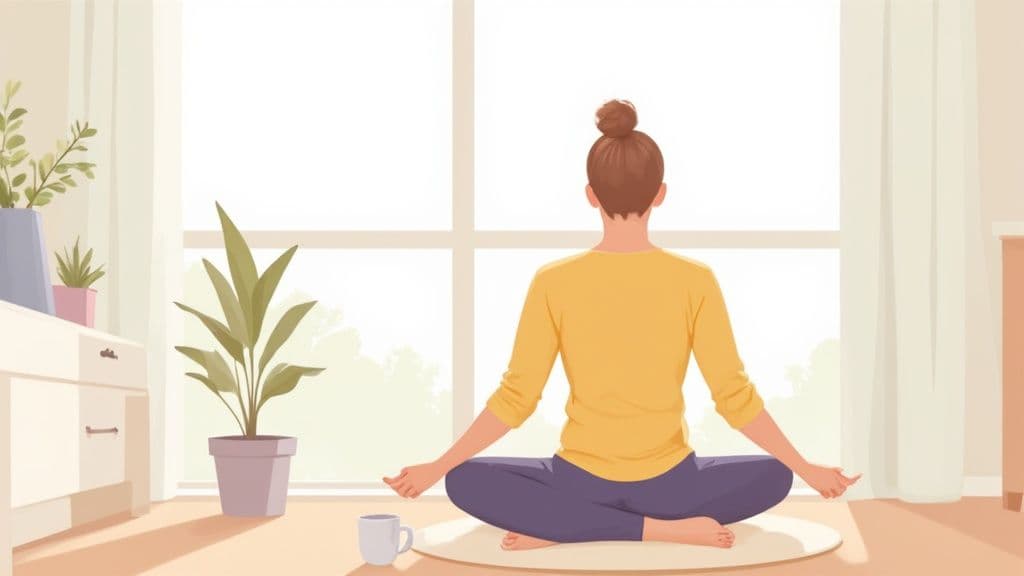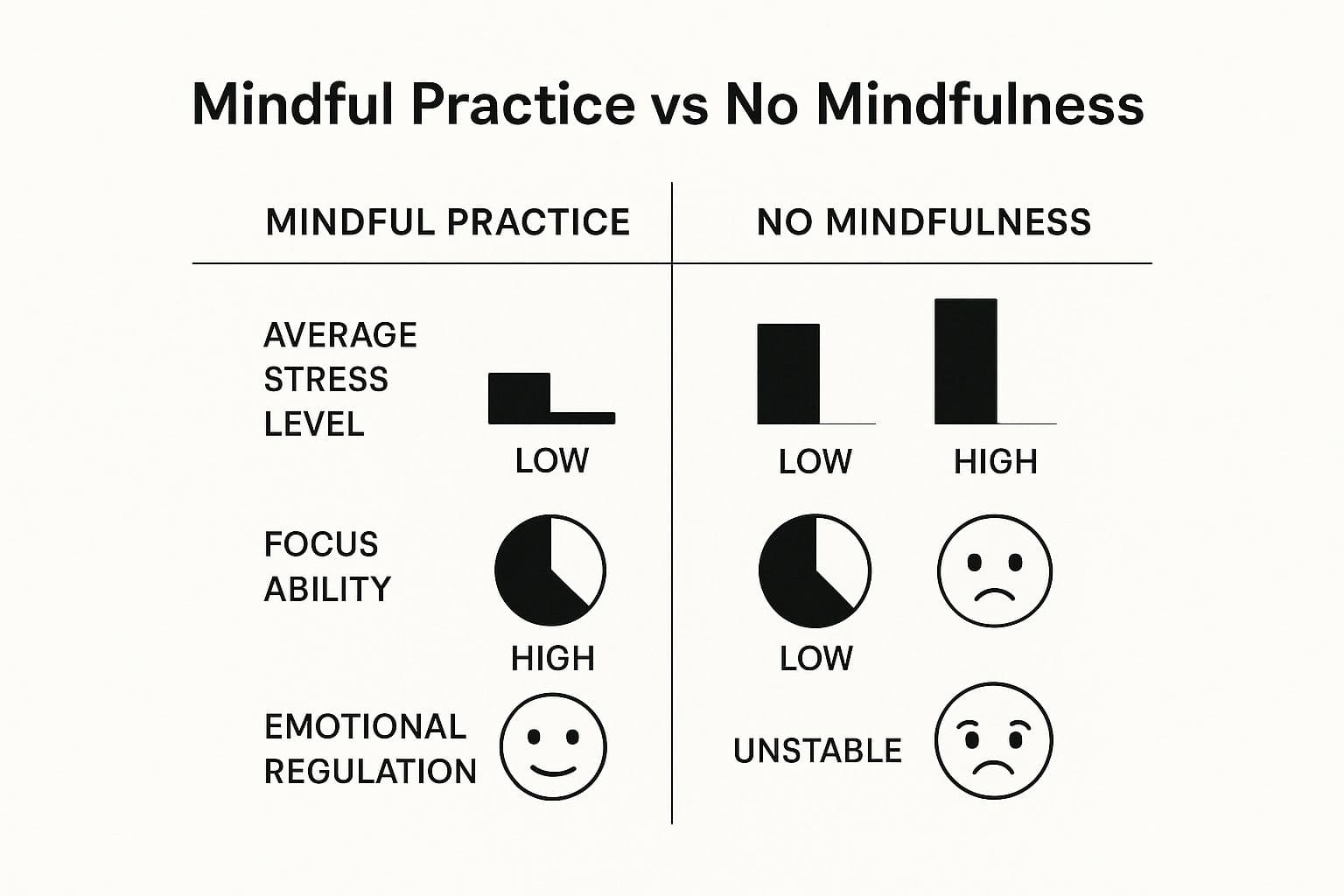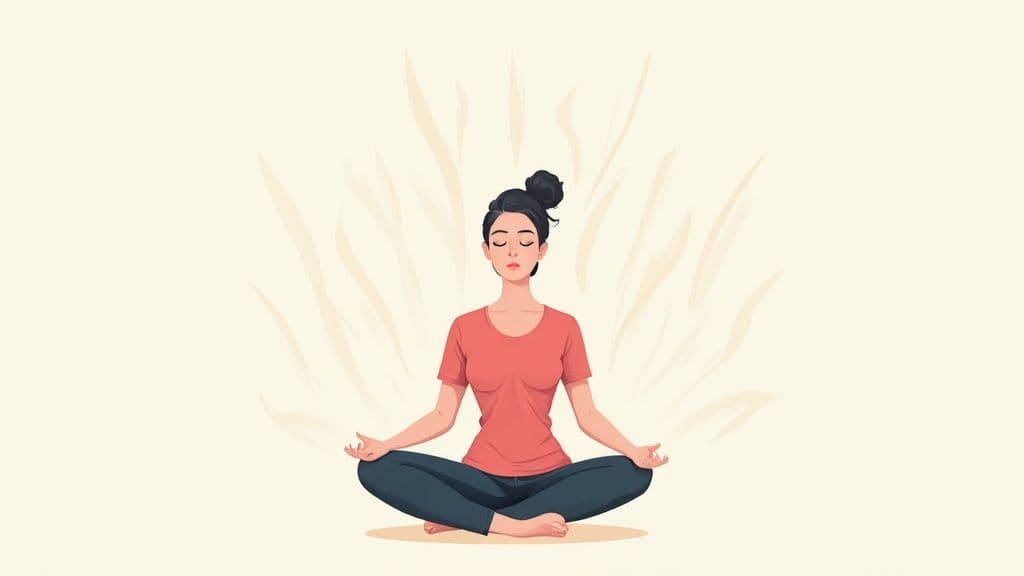Mindfulness is a practical skill you can use anytime to feel calmer and more focused. This guide offers short, approachable exercises and realistic tips to help you start and sustain a daily practice, even on busy days.
September 25, 2025 (3mo ago) — last updated December 10, 2025 (14d ago)
Daily Mindfulness Practices for Calm & Focus
Short, practical mindfulness exercises and tips to reduce stress, boost focus, and build a daily habit—even on busy days.
← Back to blog
Daily Mindfulness Practices for Calm & Focus
Summary: Simple mindfulness exercises and practical tips to reduce stress, boost focus, and build a daily habit—even on busy days.
Introduction
Mindfulness is a practical skill you can use anytime to feel calmer and more focused. This guide offers short, approachable exercises and realistic tips to help you start and sustain a daily practice, even on the busiest days.
If you’re new to mindfulness, begin by paying attention to the present moment on purpose, without judging it. The simplest entry point is the breath: spend one minute noticing air moving in and out of your body and let that sensation anchor you.
What Mindfulness Really Means
Mindfulness isn’t about emptying your mind or stopping thoughts. Instead, it’s learning to observe thoughts and feelings without getting tangled in them. Practicing this gentle observation creates space and reduces reactivity.
I remember when my work-life balance was a mess and my mind ran on a loop of to‑do lists and worries. A friend suggested mindfulness and I was skeptical. I didn’t have time to sit and do nothing. Desperate enough to try, I did a one‑minute breathing exercise. Just sixty seconds of focused breath offered a small anchor. It didn’t fix everything, but it broke the cycle of frantic thinking and helped me develop self‑awareness. For more on self‑awareness, see our guide on how to develop self-awareness.
Debunking Common Mindfulness Myths
| Common Myth | The Reality |
|---|---|
| You must have a completely clear mind. | Your mind will wander. The practice is gently returning your attention each time. |
| It takes hours of practice. | Even a few minutes a day can make a difference. Consistency matters more than duration. |
| Mindfulness is a religious practice. | Modern mindfulness is commonly taught as a secular skill, though it has ancient roots. |
| It’s a way to escape your problems. | Mindfulness helps you face thoughts and feelings with awareness, not avoid them. |
Seeing the reality behind these myths makes the practice more accessible. It’s not about perfection; it’s about paying attention.
This image highlights measurable benefits of consistent mindfulness practice.

Research links mindfulness training to lower stress, improved attention, and better emotional regulation2. Since the Mindfulness‑Based Stress Reduction (MBSR) program began in 1979, mindfulness has been adapted widely in clinical and workplace settings1.
Your First Mindfulness Exercises

You don’t need special equipment or lots of time. A few minutes and a curious mind are enough. These exercises are starting points; the goal isn’t to force your mind blank, it’s to bring attention back to the present repeatedly and without judgment.
The Mindful Breath
Your breath is always available as an anchor. Find a comfortable position—sit or lie down—soften your gaze or close your eyes, and notice your breathing. Don’t change it; simply observe sensations like cool air at the nostrils, the rise of your chest, or the fall of your belly.
Your mind will wander; that’s normal. When you notice it, gently note the thought and return to the breath. Each redirection strengthens attention.
The Body Scan
The body scan reconnects you with physical sensations and eases overwhelm. Lie down comfortably and bring attention to your left toes. Notice sensations—tingling, warmth, pressure—without judgment. Move slowly up the left leg, then the right, through the torso, arms, neck, and face. If you find tension, simply observe it.
To explore this connection further, see our guide on meditation for self-discovery.
Mindful Seeing
You don’t need a quiet room to practice. Pick an object nearby—a plant, a mug, your hand—and look at it as if you’ve never seen it before. Notice colors, textures, and light without labeling. This practice pulls you into the present.
A meta‑analysis found mindfulness programs produce small to moderate improvements in anxiety, depression, and stress-related outcomes, and many meditators report regular practice sessions of about 10–20 minutes2.
Weaving Mindfulness Into a Busy Day

You don’t need extra time. Mindfulness is about noticing moments already in your day. This shift makes it a natural part of life instead of one more chore.
Turning Everyday Actions Into Mindful Moments
Bring attention to routine tasks. A few favorites:
- Morning coffee: Pause before checking your phone. Notice the aroma, the warmth, the taste of the first sips.
- Washing dishes: Focus on sensations—the water’s warmth, the soap’s texture, the sound of plates. Short, sensory moments calm the mind.
- Walk to the car: Slow down slightly. Feel each step and notice the air on your face.
These small anchors add up and help reduce overwhelm. For workplace strategies, see our piece on workplace stress management techniques.
Piggybacking On Existing Habits
Attach mindfulness to daily actions, a method called habit stacking. Examples:
- Brushing your teeth: Focus on sensations for two minutes.
- Waiting in line: Do a quick body scan. Notice shoulder or jaw tension and release.
- Before email: Take three slow breaths to create a calm buffer.
These short practices aren’t formal sessions but powerful ways to ground yourself.
Common Challenges and How to Navigate Them
Practice isn’t always easy. Boredom, restlessness, and a wandering mind are normal and part of the work. These moments are opportunities to build resilience.
Wandering Mind
Your mind will drift. Use gentle redirection rather than force.
- Label it: When a thought appears, silently note “thinking.”
- Return: Guide attention back to your anchor. Each return strengthens attention.
Boredom and Restlessness
Curiosity helps. Notice where restlessness lives in your body—a buzzing in the legs or tightness in the chest. Observing without reacting teaches you to tolerate discomfort.
Lack of time and distractions are common barriers, and many people benefit from reminders, community support, or short guided practices to stay consistent2.
When Difficult Emotions Surface
Mindfulness isn’t about getting rid of emotions. It’s about holding them with compassion. When sadness or anxiety appear, name the feeling—“Ah, this is anxiety”—and allow it to be present. Observing emotions with kindness reduces their intensity over time.
Deepening Your Awareness
After basic breathwork and body scans, you can expand into practices that affect relationships and the way you show up.
Expanding Your Toolkit
- Mindful Listening: When someone speaks, listen fully without planning your response. Notice tone and body language.
- Loving‑Kindness Meditation: Start with compassion for yourself, then extend it to loved ones, acquaintances, and even difficult people.
These practices shift you from “me” to “we.”
Exploring Complementary Frameworks
As awareness grows, some people explore other frameworks to better understand life themes and purpose. For example, Dan Millman’s book The Life You Were Born to Live and the Life Purpose App offer tools for self‑inquiry and goal focus. These tools can complement mindfulness by pointing to areas where applied awareness may have the most impact.
Learn more with the Life Purpose App at https://lifepurposeapp.com.
Quick Q&A
Q: How long should I practice each day?
A: Start small—try five minutes daily, or one minute if five feels too much. Consistency matters more than session length.
Q: What if my mind wanders during practice?
A: That’s normal. Gently note the distraction and return to your anchor. Each redirection strengthens attention.
Q: How can I fit mindfulness into a busy schedule?
A: Attach short practices to habits you already have—brushing teeth, waiting in line, or before checking email.
Three Concise Q&A Summaries
Q: Will mindfulness really reduce stress?
A: Yes. Research shows mindfulness programs reduce stress and improve emotional regulation over time2.
Q: Do I need special training or apps?
A: No—basic practices are simple and free. Guided apps can help build habit and teach techniques.
Q: Can mindfulness help at work?
A: Yes. Organizations that support mindfulness report benefits in employee well‑being and reduced costs in some cases3.
Discover Your Life Purpose Today!
Unlock your true potential and find your life’s purpose.
